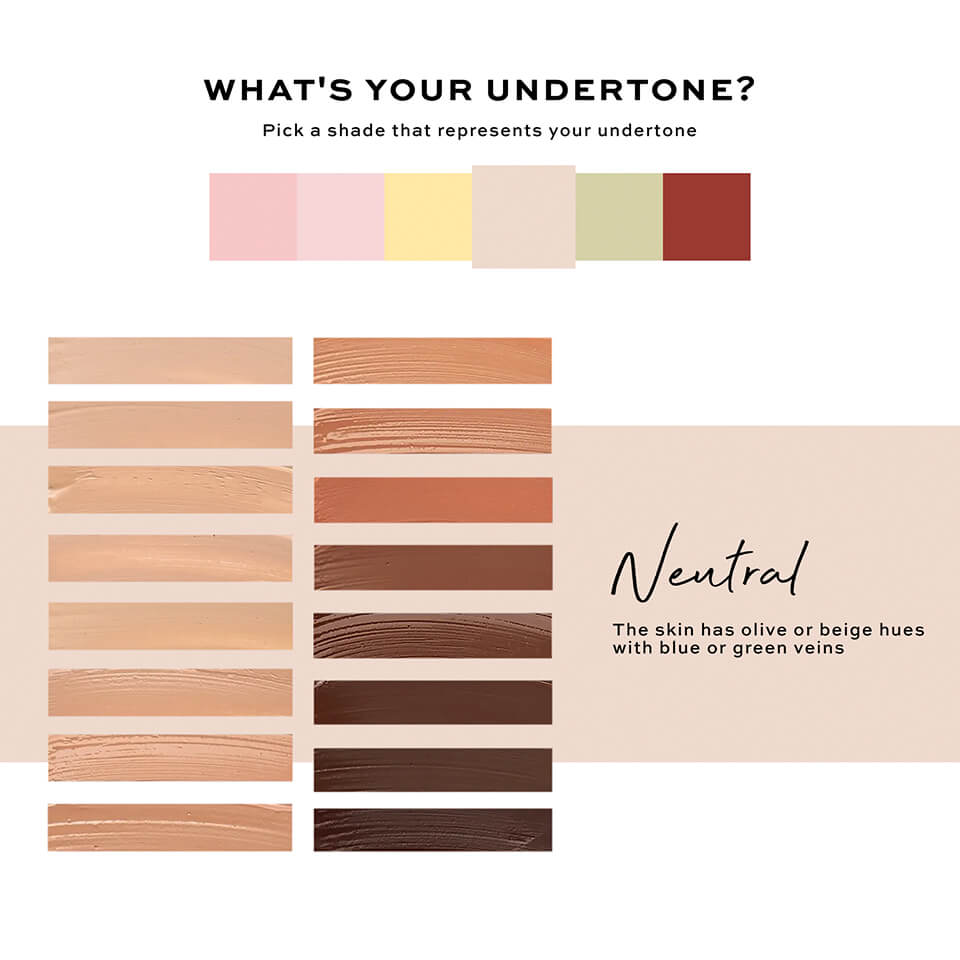To find your foundation shade accurately and easily, follow these simple steps.
Table of Contents
Understanding Your Skin Tone
Discovering your skin tone is crucial to finding the perfect foundation shade. Consider factors like undertone, surface color, and natural lighting to determine the most accurate match. It’s essential to test shades on your jawline to ensure a seamless blend with your skin.
When it comes to finding the perfect foundation shade that flawlessly matches your skin, understanding your skin tone is crucial. Your skin tone has two main components: undertones and surface tone. By understanding these factors, you can easily determine your foundation shade and achieve a natural and radiant complexion.

Undertones
To determine your undertones, you need to closely examine the color underneath your skin’s surface. Undertones can be categorized into three main groups: cool, warm, and neutral.
- Cool undertones: If your undertones have a bluish, pink, or rosy hue, you have a cool undertone. Silver jewelry usually complements cool undertones well.
- Warm undertones: Having undertones that appear yellow, peachy, or golden means you have warm undertones. Gold jewelry often flatters warm undertones.
- Neutral undertones: Individuals with neutral undertones have a balance of both cool and warm undertones. They often have a mix of blue and green veins on their wrists and can wear both silver and gold jewelry.
Skin Surface Tone
After determining your undertones, it’s important to consider your skin surface tone. This refers to the shade or color you see on the surface of your skin. Skin surface tone can be categorized into three main groups: fair, medium, and deep.
- Fair skin surface tone: Fair-skinned individuals have a lighter complexion that’s prone to sunburn. They often have freckles and might have cool, warm, or neutral undertones.
- Medium skin surface tone: Medium-toned individuals have a moderate complexion that tans easily and rarely burns. They might have cool, warm, or neutral undertones.
- Deep skin surface tone: Deep-skinned individuals have a rich, dark complexion that rarely burns and always tans easily. They might have cool, warm, or neutral undertones.
Understanding your skin tone, including both undertones and surface tone, is the key to finding a foundation shade that looks seamless and enhances your natural beauty. By keeping the undertones and surface tone in mind, you can confidently choose a foundation that matches your complexion perfectly.

Credit: jeninegrimaudo.com
Identifying Your Undertones
Identifying your undertones is crucial for finding the perfect foundation shade. Discovering whether you have warm, cool, or neutral undertones will help you choose the right color that enhances your natural beauty.
When it comes to finding the perfect foundation shade, identifying your undertones is crucial. Undertones are the subtle hues that determine whether your skin has warm, cool, or neutral characteristics. Understanding your undertones will help you choose a foundation shade that complements your natural complexion, ensuring a seamless and natural-looking finish.
Warm Undertones
If your skin undertones are warm, you may notice hints of yellow, peach, or golden hues in your complexion. To confirm if you have warm undertones, check the veins on your wrist. If they appear more greenish, it’s a sign of warm undertones. People with warm undertones often tan easily and have a natural radiance to their skin.
When selecting a foundation shade for warm undertones, opt for shades with a yellow or golden base. Look for shades labeled “warm,” “golden,” or “golden beige.” These shades will help enhance your natural warmth and give your skin a healthy glow.
Cool Undertones
On the other hand, if your undertones are cool, you may notice a hint of pink, blue, or red in your skin. To determine if you have cool undertones, look at your veins again. If they appear more bluish, it means you have cool undertones. Those with cool undertones may burn easily under the sun and have a porcelain-like complexion.
For cool undertones, choose foundation shades with a pink or rosy base. Look for shades labeled “cool,” “porcelain,” or “rosy beige.” These shades will help balance and enhance the natural coolness in your skin, leaving you with a fresh and vibrant complexion.
Neutral Undertones
If your skin undertones are neutral, you have a balance between warm and cool hues. Your skin may not seem overly yellow, pink, or peachy, and your veins may appear bluish-green. Neutral undertones are versatile and can pull off both warm and cool foundation shades.
When selecting foundation for neutral undertones, choose shades labeled “neutral,” “beige,” or “natural.” These shades will help enhance your natural skin tone without overpowering the warmth or coolness of your complexion.
Determine Your Skin Surface Tone
When determining your foundation shade, the first step is to identify your skin surface tone. This involves assessing the undertones and surface color of your skin to ensure a seamless match. Let’s explore the specific considerations for fair, medium, and deep surface tones.
Fair
For fair skin tones, it’s essential to look for foundation shades with undertones that complement the natural pink or peach hues in your skin. Opt for cool or neutral undertones to enhance your complexion without creating an overly warm or yellowish appearance.
Medium
Medium skin tones require foundation shades that balance undertones to avoid creating an ashy or overly warm finish. Neutral or warm undertones can provide a harmonious match for medium skin, enhancing the natural radiance without appearing too rosy or golden.
Deep
When selecting foundation shades for deep skin tones, focus on warm or red undertones to complement the deep cinnamon, caramel, or ebony hues. These undertones can enrich the complexion and prevent the foundation from appearing overly cool or neutral, delivering a rich and flattering finish.

Credit: www.100percentpure.com
Testing Foundation Shades
When it comes to finding the right foundation shade, testing is key. Swatching the different shades, evaluating them
in natural lighting, and considering a few important factors will lead you to your perfect match. Let’s
explore these methods in detail:
Swatching
Swatching is an essential step in determining your foundation shade. It involves applying a small amount of the
foundation on your jawline or the side of your face to compare it against your skin tone. Here’s how you can
effectively swatch:
- Start with a clean face, ensuring it is free from any makeup or skincare products.
- Choose a few foundation shades that you believe might match your skin tone.
- Apply a small stripe of each shade along your jawline or on the side of your face.
- Blend the foundation gently using your fingertips or a foundation brush.
- Observe the shades in natural lighting to see how they blend with your skin tone.
- Compare each swatch to determine which shade looks most seamless and matches your complexion.
Natural Lighting
Evaluating foundation shades under natural lighting is crucial. Natural light offers the most accurate representation
of how the foundation will appear on your skin throughout the day. Follow these steps to assess the shades in
natural lighting:
- Find a room with ample natural light, near a large window or open space.
- Apply the swatched foundation shades on your jawline or the side of your face.
- Step outside or position yourself near the window to examine the shades.
- Observe how the shades blend with your natural skin tone in different lighting conditions.
- Consider any color changes, undertones, or inconsistencies that may occur under natural light.
By evaluating the foundation shades under natural lighting, you can ensure a seamless and complementary match for
your complexion.
In addition to swatching and assessing shades in natural lighting, it’s crucial to consider other factors such as
your undertone, skin type, and personal preferences. Incorporate these steps into your foundation shade testing
routine, and you’ll be well on your way to finding your perfect match.
Finding The Right Match
One of the most important aspects of achieving a flawless makeup look is finding the perfect foundation shade that matches your skin tone. However, with so many options available, it can feel overwhelming and confusing. Don’t worry, we’ve got you covered! In this section, we will explore some effective ways to find your foundation shade, ensuring a seamless match for a natural, radiant complexion.
Mixing Shades
One method to find your ideal foundation shade is by mixing different shades together. This technique allows you to create a customized color that perfectly matches your unique skin tone. Start by identifying two shades that are closest to your skin tone. Using a clean palette or the back of your hand, squeeze a small amount of each shade and blend them together until you achieve a color that seamlessly disappears into your skin.
By mixing shades, you have the flexibility to adjust your foundation color based on the changing seasons or any subtle changes in your skin tone throughout the year. This technique enables you to easily adapt and maintain a natural-looking complexion regardless of external factors.
Seek Professional Advice
If you find it challenging to determine your foundation shade on your own or want expert guidance, it’s always worth seeking professional advice. Visiting a makeup counter or beauty store where trained professionals specialize in matching foundation shades can be extremely helpful.
Makeup professionals have an excellent understanding of different skin tones, undertones, and product formulations. They can assess your skin and recommend the most suitable foundation shade and type for you. These experts have access to a wide range of brands and shades, ensuring that you will have various options to choose from in order to find your perfect match.
Remember, professional advice can be particularly beneficial when you’re trying out a new brand or formulation, as they can guide you through the unique qualities and nuances of different products.

Credit: www.revolutionbeauty.com
Frequently Asked Questions For How To Find Your Foundation Shade
How Do I Find My Foundation Shade?
Finding your foundation shade can be tricky. Start by determining your undertone, then test shades on your jawline. Consider your preferences for coverage and finish. Don’t forget to check the shade in natural lighting for the most accurate match. And remember, it may take some trial and error to find the perfect shade for you.
What If I Can’t Find My Exact Foundation Shade?
If you can’t find your exact foundation shade, don’t worry! Mix two shades together to create a custom blend. You can also try adjusting the shade with a color corrector or using a tinted moisturizer instead. Remember, the goal is to find something that enhances your natural skin tone and makes you feel confident.
Should I Match My Foundation Shade To My Face Or Neck?
Ideally, you should match your foundation shade to your neck. This ensures a seamless transition and avoids a noticeable line of demarcation. If your face and neck are not the same shade, choose a foundation that matches your neck and blend it onto your face for a natural, uniform look.
Can I Rely On Online Shade Match Tools?
Online shade match tools can be helpful, but they’re not foolproof. They rely on algorithms and may not take into account your unique undertones and skin characteristics. It’s always best to try the foundation in person or get a sample before making a purchase.
Conclusion
Finding the perfect foundation shade is essential for a flawless makeup look. By understanding your undertone and skin type, you can easily determine the right shade. Experiment with different options and don’t be afraid to seek professional advice. Remember, the key is to enhance your natural beauty and feel confident in your own skin.